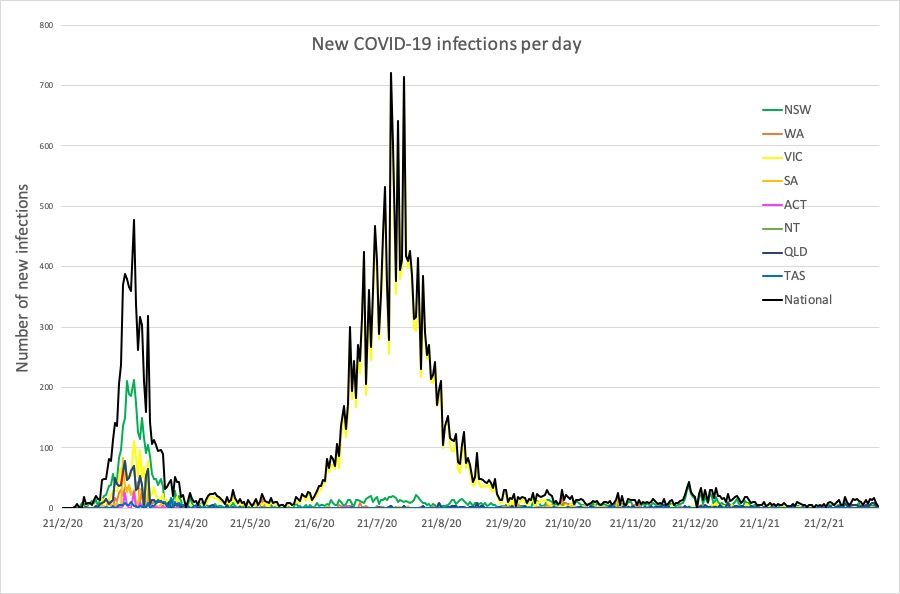And young children may lower the COVID-19 risk in their household.
Welcome to The Medical Republic’s COVID Catch-Up.
It’s the day’s COVID-19 news in one convenient post. Email bianca@biancanogrady.com with any tips, comments or feedback.
22 March
- Vaccine rollout moves into phase 1b, but floods create problems for GP deliveries.
- Young children associated with lower risk of COVID-19 in a household.
- SARS-CoV-2 infection in pregnancy linked to preeclampsia, stillbirth and low birth weight.
- Latest COVID-19 infection numbers from around Australia.
The second phase of Australia’s vaccine rollout launches today, adding those aged 70 years and over, Indigenous Australians aged over 55 years, adults with certain medical conditions, and those in critical or high-risk occupations to the list of people now eligible for vaccination.
So far around 282,000 doses of the Pfizer/BioNTech vaccine have been delivered in the phase 1a of the program, which was forecast to deliver up 1.4 million doses.
Meanwhile, Australian pharmaceutical/biotechnology companies CSL-Behring and Seqirus have received the green light from the Therapeutic Goods Administration to manufacture the AstraZeneca/Oxford vaccine in Australia.
According to a statement from the TGA, CSL-Behring will produce the active raw materials for the vaccine, and Seqirus will manufacture and package the finished product. The first batches are expected to be released in the next few days, and will also undergo testing and verification by the TGA.
The wild weather and flooding also appears to be delaying the government’s vaccination schedule, with GPs taking to social media to report delivery no-shows. Some said they have hundreds of patients booked for their vaccinations, and were desperately trying to reorganise their clinics.
That’s true collaboration between primary and hospital care! Jealous after my clinic had to make >400 cancellation phone calls over the weekend to delay appointments by a week ?
— dr_bowerbird (@dr_bowerbird) March 21, 2021
Children in a household may lower the risk of adults in the same household contracting COVID-19 or developing severe disease, according to new research published in the Archives of Disease in Childhood.
A study of 310,097 adults living in a household with a healthcare worker and varying numbers of children found the greater the number of young children, the lower the risk of adults requiring hospitalisation with COVID-19.
Each additional young child was associated with a 7% reduction in risk of hospitalisation and in the risk of infection, after adjusting for the age of adults in the household and other factors including adult profession, comorbidities and sex.
The association was strongest for preschool children, and remained significant after schools reopened in the UK.
The authors suggested that children may enhanced adults’ immunity to SARS-CoV-2 through cross-reactive protection from exposure to other coronaviruses.
“In this context, our current study provides reassurance that adults sharing a household with young children remained at no increased risk of COVID-19 during August–October 2020 when schools were reopened and community transmission of SARS-CoV-2 was occurring,” the authors wrote.
COVID-19 in pregnancy is associated with significant increases in the risk of pre-eclampsia, preterm birth and low birth weight babies, according to a systematic review and meta-analysis.
The paper, published in the Canadian Medical Association Journal, examined 42 studies involving more than 438,000 pregnant women. The analysis suggested a 33% higher odds of preeclampsia, 82% higher odds of preterm birth, more than two-fold greater odds of stillbirth, nearly five-fold greater odds of ICU admission, and mean birth weight that was nearly 70 grams lower in women infected with SARS-CoV-2 compared to those without.
Here are the latest COVID-19 infection numbers from around Australia to 9pm Sunday:
National – 29,196 with 909 deaths
ACT – 123 (0)
NSW – 5261 (2)
NT – 106 (1)
QLD – 1417 (2)
SA – 642 (0)
TAS – 234 (0)
VIC – 20,483 (0)
WA – 930 (0)



